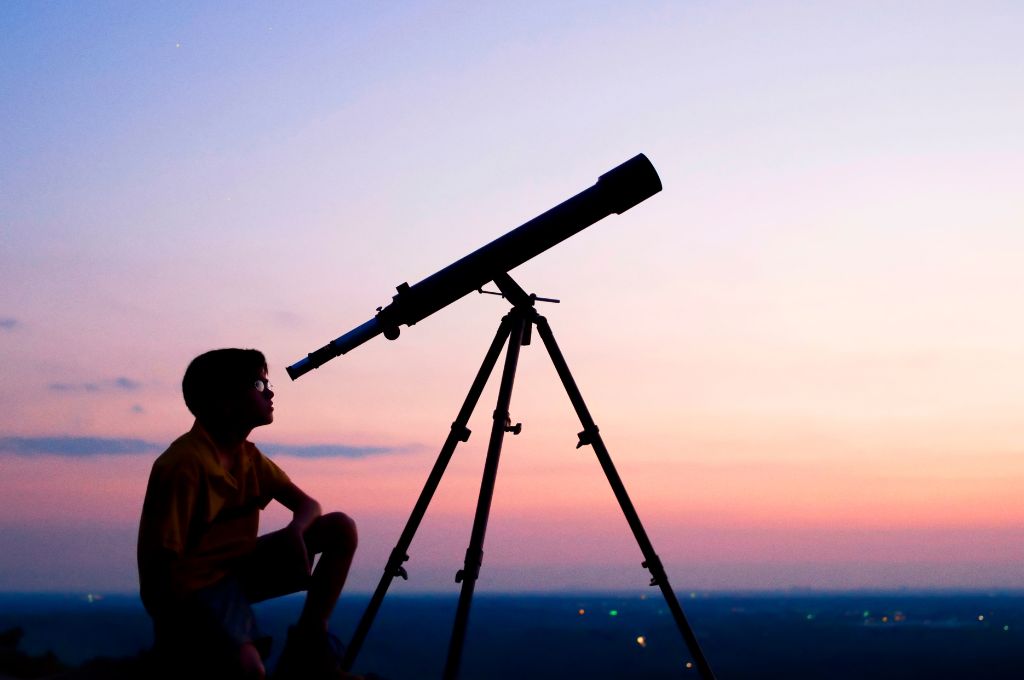When it comes to telescopes, you’ll often hear folks talking about focal length and focal ratio, and sometimes in the same sentence. This can be a little confusing if you’ve never heard these terms before, but they’re both relatively easy to understand – especially once you know how one impacts the other. So what do these terms mean, and how are they connected?
What is Telescope Focal Length?
The concept of focal length is actually quite simple, but may seem a little confusing at first. Essentially, it’s the distance that light travels from a primary lens or mirror to the focal point, where the light forms an image.
But what does this mean?
Regardless of the type of telescope you have, they all work in a similar fashion. The two most common types of telescope are refractors and reflectors. One end of the telescope will either be open (reflectors), or it will have a glass lens (refractors). This is the end you point toward your target.
Refractors use the glass lens to gather light, whereas reflectors use a mirror (called the primary mirror) at the bottom of the telescope tube. This lens (on a refractor) or primary mirror (on a reflector) is the starting point for the focal length.
In a refractor, the light then exits through the focuser at other end of the telescope tube. In a reflector, the primary mirror reflects the light back up the tube to a secondary mirror, which then bounces the light out through the focuser to the eyepiece.
The diameter of the lens or mirror is called the aperture and it’s typically measured in millimeters or inches. For example, you might hear someone say they have a 250mm reflector, which means their telescope has a mirror 250mm (10 inches) in diameter.
(Incidentally, for practical reasons, the majority of refractor telescopes used by amateurs have apertures no larger than about 114mm or roughly 4.5 inches.)
In order to see your target, you need to look through an eyepiece, and the view will need to be focused by turning a dial which will then move the eyepiece back and forth. This dial adjusts the focuser, and this is the end point of the focal length.
If this all sounds very technical, then don’t worry! You won’t need to calculate the focal length yourself, as there should be a label on your telescope (often close to the focuser) that will specify this for you.
Want to get started in astronomy?
Our free telescope cheat sheet breaks down the key factors to choosing a telescope and shows you how to get stunning views of planets, nebula, and galaxies!

Focal length and magnification
Knowing the focal length of your telescope is essential, as without it you won’t know the magnification of the eyepiece you’re using. This, in turn, will allow you to get a good idea of which magnification is best for observing specific targets. For example, a low magnification of no more than about 35x is all you need to enjoy the Pleiades star cluster, but if you want to study Jupiter or Saturn, you’ll need a much higher magnification.
Calculating the magnification of an eyepiece is very simple, but besides knowing the focal length of your telescope, you’ll also need to know the focal length of the eyepiece you’re using. Fortunately, the focal length of an eyepiece is determined in much the same way as the focal length of your telescope – it’s the distance that light travels from the point of entry to the point where the image is formed. Also, again, the focal length is measured in millimeters and can be found on the eyepiece itself, usually at the top.
(Eyepiece focal lengths typically range from 6mm to around 30mm, but there are also shorter and longer focal length eyepieces available.)
To calculate the magnification of your eyepiece, you simply divide the focal length of your telescope with the focal length of the eyepiece itself.
For example, let’s say your telescope has a focal length of 900mm and it came with two eyepieces: a 20mm and a 10mm. The 20mm eyepiece will give you a magnification of 45x (900 / 20 = 45) while the 10mm eyepiece will give you twice that magnification, 90x (900 / 10 = 90).
Obviously then, an eyepiece will produce a different magnification in a different telescope. If you used those same two eyepieces in a telescope with a focal length of 1200mm, you’d get a higher magnification for each one. Specifically, the 20mm would produce a magnification of 60x (1200 / 20 = 60) while the 10mm would produce a magnification of 120x (1200 / 10 = 120).
Things to remember about focal length
As a general rule, telescopes with a longer focal length can produce higher magnifications and are therefore better for observing planets, planetary nebulae and galaxies. However, it’s worth remembering that if you want to seriously study these objects, you should also aim for a scope with a larger aperture. A larger aperture means your scope can gather more light, and the more light it can gather, the fainter the object you’ll be able to see and the more detail will be visible.
A long focal length without the aperture to back it up is nearly useless, as you won’t be able to see much at all. If you had two 150mm aperture scopes, one with a focal length of 1200mm and one with a focal length of 900mm, you wouldn’t necessarily see more with the 1200mm focal length scope. The view might appear larger because it’s capable of a higher magnification, but since it has the same aperture as the 900mm scope, you won’t see any fainter objects or any greater detail.
On the flip side, eyepieces with longer focal lengths produce lower magnifications, but they use a larger lens, which makes for a more comfortable viewing experience. Shorter focal length eyepieces produce a higher magnification, but the smaller lens makes it harder to look through.
Something else to remember is that since telescopes with longer focal lengths produce higher magnifications, if you want a low magnification you’ll need an eyepiece with a longer focal length. For example, let’s say you had two telescopes, one with a focal length of 900mm and the other with a focal length of 1200mm.
If you wanted to observe the Pleiades star cluster at 30x through both, you’d need a 30mm eyepiece for the scope with a focal length of 900mm, but a 40mm eyepiece for the scope with a focal length of 1200mm.
Again, it’s relatively easy to find eyepieces with focal lengths of up to 30mm, but if you need anything longer you might run into problems.
What is Focal Ratio?
Focal ratio (or f ratio), like focal length, is another term you’ve probably heard other astronomers talk about, especially if they’re into astrophotography. Put simply, the focal ratio is an indication of the ‘speed’ of the telescope.
Calculating the focal ratio of your telescope is pretty easy, as you only need to divide its focal length (measured in millimeters) by its aperture (again, in millimeters). For example, if your scope has a focal length of 2500mm and an aperture of 254mm (10 inches), then it has a focal ratio of 1:9.8. (2500 / 254 = 9.8)
This ratio is always written as f/X.X, and in this example, your telescope is said to have a focal ratio of f/9.8 (although the manufacturer might round it up to 10 for the sake of convenience.)
Why is the focal ratio important?
The lower the focal ratio, the ‘faster’ the scope is said to be. Unfortunately, there’s no clear consensus on what defines a fast or a slow scope, but as a general rule, anything f/5 or below is considered to be fast, whereas anything f/9 or above is considered to be slow. Focal ratios between f/6 and f/8 are considered to be neither fast or slow, but rather, if anything, to be of medium speed instead.
Fast scopes tend to produce lower magnification views, but with a wider field of view and a brighter image. Slower scopes are capable of producing higher magnifications and smaller fields of view.
Faster scopes are therefore great for observing larger targets, such as star clusters and the larger nebulae, globular clusters and galaxies. Slower scopes are better suited to smaller targets, such as planets, planetary nebulae, many smaller globular star clusters and galaxies. (If your scope has a focal ratio of between f/6 and f/8, it’s probably a good all-round choice for any number of potential targets.)
Astrophotographers may prefer faster scopes as they can record an image in less time than their slower counterparts. For example, if you had an f/5 and an f/10 scope, the exposure time for the f/5 would be a quarter that of the f/10 – but you’d also have to contend with a lower magnification.
Lastly, slower scopes tend to produce a better quality image, so if you’re using a fast scope for visual observing, you may need to invest in better quality eyepieces to compensate.

Barlow Lenses and Focal Reducers
Just because your scope has a focal length and/or a focal ratio that’s not ideally suited to your needs, it doesn’t mean you have to suffer with that, and not surprisingly, there a few solutions that can help you.
The benefits of a Barlow lens
Let’s say you have a telescope with a focal length of 650mm. While this is certainly capable of producing some fine views at magnifications greater than 100x, you’d need to use an eyepiece with a short focal length of around 6mm to get it. As mentioned above, eyepieces with short focal lengths can be uncomfortable to use, as the eyepiece lens is much smaller and produces a smaller field of view.
This is where a Barlow lens can be a life saver. It takes the magnification of your eyepiece and then multiplies it by a factor of between 2x and 5x, depending on the specifications of the Barlow itself.
This has a number of important benefits.
Firstly, it increases the number of magnifications you have available to you, without having to spend money on a range of new eyepieces. If you had a scope with a focal length of 900mm and two eyepiece – a 10mm and a 20mm – you would have two magnifications available to you: 90x and 45x. Use a 2x Barlow with the 10mm and you’ll have a third magnification available to you: 180x.
Use a 3x Barlow instead and you’ll double your magnifications. Besides 45x and 90x, you’ll get 135x from the 20mm and 3x Barlow combo and 270x from the 10mm and 3x Barlow combo.
Another, equally important benefit is that while you can increase the magnification of the eyepiece, you won’t reduce the field of view. Again, to use the preceding example, if your scope had a focal length of 900mm, you’d get a magnification of 45x from the 20mm and a magnification of 90x from the 10mm – but the 10mm would have a smaller field of view. Use the 2x Barlow with the 20mm and you’ll get 90x, but at the same, comfortably wide field of view that you had at 45x.
In this situation, the Barlow lens is effectively doubling the focal length of the telescope. Use a 3x Barlow and the focal length is tripled, whereas a 5x Barlow would, of course, increase the focal length by a factor of five.
Little wonder that the humble Barlow lens is considered an essential accessory by almost every amateur astronomer!
How to reduce your telescope’s focal length
Compare that to a focal reducer, which, as its name implies, does exactly the opposite. It cuts the focal length of a telescope, allowing a scope with a high focal length to produce lower magnification views. Alternatively, you can use a focal reducer on a telescope with a short focal length to produce even lower magnification views.
Why would you do this? Lower magnifications are often preferred for star clusters, as they tend to appear fairly large through the eyepiece. If you have a large aperture scope, with a high focal length, you can now observe these clusters at a lower magnification and see the entire cluster within the field of view. Better yet, larger aperture scopes will still be able to gather more light than their smaller counterparts, making it possible to see far more stars.
A focal reducer is also important when it comes to astrophotography, as it will make your scope faster and reduce the exposure time needed to capture your image.
Focal reducers, like Barlow lenses, come in several varieties and will specify their effect on the magnification. For example, a 0.5x focal reducer will halve the magnification, so if your eyepiece normally produces a magnification of 50x, it will now produce a magnification of 25x (50 x 0.5 = 25).
A 0.7x focal reducer will decrease the magnification by 30%. Again, if your eyepiece normally produces a magnification of 50x, you’ll now get 35x instead. (50 x 0.7 = 35).
Traditionally, focal reducers haven’t been as widely used as Barlow lenses, and tend to cost more, but both should have a place reserved for them in the astronomer’s toolbox!
Want to get started in astronomy?
Our free telescope cheat sheet breaks down the key factors to choosing a telescope and shows you how to get stunning views of planets, nebula, and galaxies!








